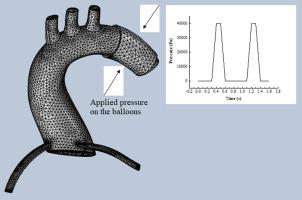IRBM ( IF 4.8 ) Pub Date : 2020-11-23 , DOI: 10.1016/j.irbm.2020.11.003 A. Heidari , S. Rahmani , C. Pop , B. Saed , A. Mahpour , M. Navidbakhsh , M. Alizadeh

|
Background
The incidence of heart failure is anticipated to rise by 2030, resulting in more than 8 million adults with this condition in US. Despite the advancement in pharmacological and surgical treatments, some patients progress to severe forms of cardiac dysfunction requiring cardiac transplantation as a last-resort treatment. Cardiac assist devices play an essential role in the recovery of normal cardiac performance through reversible remodeling or in assisting the weak organ to prolong survival rate. However, these devices need to be monitored carefully, as prolonged use may lead to physiological maladaptation and further cardiac complications. The optimization of such devices has done through the development and use of numerical simulations that allow the analysis of in-vivo hemodynamic patterns of blood flow. This study aims to investigate the performance of a model of extra-aortic assist device surrounding the descending aorta through three-dimensional patient-specific modeling.
Methods
A three-dimensional model of the aorta was constructed from patient-specific cardiac CT images of a 60-year-old male diagnosed with left ventricular failure at the Tehran Heart Center (THC). Numerical simulation was conducted for two complete cardiac cycles using fluid-structure interaction (FSI) analysis under the assumption that the balloon and the aortic vessel behave as linear elastic materials, and that blood is a Newtonian and incompressible fluid.
Results
The numerical simulation demonstrated a high correlation between the FSI analysis and clinical data of the patient-specific anatomical and physiological conditions. Blood velocity, pressure, deformation, and strain contours were simulated and analyzed through three-dimensional modeling. Compared to the unassisted aorta, the device provided an increase in blood flow displacement of an additional 15 ml of blood in the descending aorta, brachiocephalic, carotid, and subclavian arteries. The maximum von Mises stress distribution across the aortic vessel was higher than the stress imposed on the system in the unassisted heart, with values of 3.3 MPa and 0.28 MPa, respectively. Numerical investigation of structural responses revealed that no remarkable force was exerted on the aortic valve by the device at the descending aorta.
Conclusion
We present the numerical investigation of a counterpulsation device around the descending aorta that has not previously been tested on human or animal models. While this extra-aortic balloon pump (EABP) did not show a significant improvement in coronary perfusion, there is room for improvement in further studies to optimize the geometry of the balloon. Additional investigations are required to determine the efficacy of this device and its safety before in-vivo experimental studies are pursued. This simulation has clinical relevance when choosing an appropriate cardiac assist device to address patient-specific physiological and pathological conditions.
中文翻译:

使用流固耦合的降主动脉辅助装置的三维计算建模
背景
预计到2030年,心力衰竭的发病率将上升,在美国将导致超过800万成年人患有这种疾病。尽管药物和外科治疗有所进步,但一些患者仍发展为严重的心脏功能障碍,需要心脏移植作为最后的治疗方法。心脏辅助设备在通过可逆重塑恢复正常心脏性能或协助弱器官延长生存率方面起着至关重要的作用。但是,这些设备需要仔细监控,因为长时间使用可能导致生理适应不良和进一步的心脏并发症。通过开发和使用数值模拟可以对此类设备进行优化,从而可以分析体内血流的血液动力学模式。
方法
根据在德黑兰心脏中心(THC)诊断为左心衰竭的60岁男性患者的特定心脏CT图像,构建了主动脉的三维模型。在气球和主动脉表现为线性弹性材料,血液是牛顿和不可压缩流体的假设下,使用流体-结构相互作用(FSI)分析对两个完整的心脏周期进行了数值模拟。
结果
数值模拟表明FSI分析与患者特定的解剖和生理状况的临床数据之间具有高度相关性。通过三维建模对血流速度,压力,变形和应变轮廓进行了仿真和分析。与无助主动脉相比,该设备在降主动脉,头臂,颈动脉和锁骨下动脉中增加了15 ml血液的血流位移。整个主动脉血管的最大冯·米塞斯应力分布高于无助心脏系统上施加的应力,分别为3.3 MPa和0.28 MPa。对结构响应的数值研究表明,降主动脉装置未对主动脉瓣施加明显的力。
结论
我们目前对降主动脉周围的反搏装置进行了数值研究,此前尚未在人或动物模型上进行过测试。尽管这种主动脉外球囊泵(EABP)并未显示出明显的冠状动脉灌注改善,但在进一步研究以优化球囊几何形状方面仍有改进的余地。在进行体内实验研究之前,需要进行其他调查以确定该设备的功效及其安全性。这种模拟具有临床相关性时选择适当的心脏辅助装置到地址患者特异性生理和病理条件。

























 京公网安备 11010802027423号
京公网安备 11010802027423号